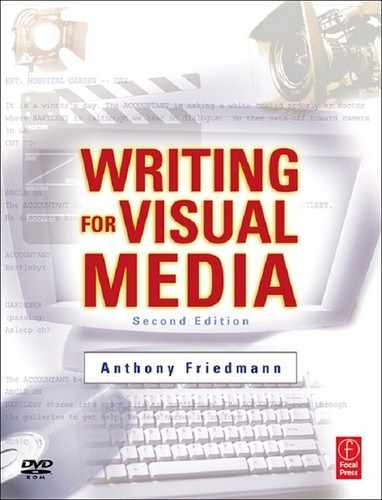Contents
1 Describing One Medium Through Another
Writing Not to be Read But to be Made
Writing, Producing, and Directing
Moving from Being a Viewer to Being a Creator
The Producer Cannot Read Your Mind
Instructions to the Production Crew
What is the Role of a Scriptwriter?
The “Script” Writer is a New Kind of Writer
Differences Compared to Stage Plays
Describing the Camera Frame or the Shot
Describing Graphics and Effects
Describing Transitions Between Shots
3 The Stages of Script Development
Background Research and Investigation
Brainstorming and Freeing Your Imagination
A First Draft Script for a PSA: Smoked to Death
4 A Seven-Step Method for Developing a Creative Concept
Step 1: Define the Communication Problem
Ivy College: An Admissions Video
American Express: American Travel in Europe
Step 2: Define the Target Audience
Step 6: Define the Appropriate Medium
A Concept for an Anti-Smoking PSA
Solving Communication Problems with Visual Media
5 Ads and PSAs: Copywriting for Visual Media
Copywriting Versus Scriptwriting
The 20-, 30-, and 60-Second Playlets
Devices to Capture Audience Attention
Recruiting the Audience as a Character
Billboards and Transportation Ads
Advertising on the World Wide Web
Typical Corporate Communication Problems
Getting Background and Product Knowledge
Video Versus Print Media or Interactive Media
Video as a Corporate Communications Tool
Script Formats for Corporate Videos
Developing the Script with Client Input
Length, Pacing, and Corporate Style
Devices that Work for Corporate Messages
Working with Budget Limitations
7 Training, Instruction and Education
Traditional Devices for Training Videos
Devices that Teach and Entertain
Educational/Instructional Use of Video
8 Documentary and Nonfiction Narratives
Scripted and Unscripted Approaches
Research and Formulating a Theme
What is the Role of the Writer?
Types of Documentary Technique
Other Documentary Applications
Entertaining with Visual Media
Three Act Structures for Film and Television
10 Writing Techniques for Long Form Scripts
11 Writing Techniques for Adaptation
Narrative Tense and Screen Time
Descriptive Detail and the Camera Frame
12 Television Series, Sitcoms, and Soaps
The Premise for Series, Sitcoms, and Soaps
Three-Act Structure and the TV Time Slot
Visualizing for the Small Screen
New Techniques and Innovations
Writing for Non-Linear and Interactive Media
13 Writing and Interactive Design
Linear and Nonlinear Paradigms
Combining Media for Interactive Use
Authoring Tools and Interactive Concepts
14 Writing for Interactive Communications
Different Writing for Web Sites
Navigation: The Third Dimension
Instructional and Utilitarian Programs
Interactive Catalogues and Brochures
15 Writing for Interactive Entertainment
E-Commerce and Interactive Books
Games, Narrative, and Entertainment
Anticipating Professional Issues
16 You Can Get Paid to Do This
Writing for the Entertainment World
Ideology, Morality, and Content
Emotional Honesty and Sentimentality
Writing for the Corporate World
Networking, Conventions, and Seminars
Dual Column: PSA, Documentary, Corporate
Master Scene Script: Feature Film for Cinema and Television
Scene Script, Version 1: Television Sitcoms and Series
Scene Script, Version 2: Television Sitcoms and Series
Interactive Game Script (This is one Type of Interactive Script)
Video Game Concept for Gods & Monsters
